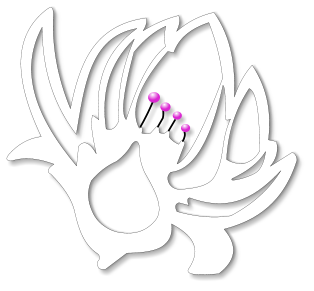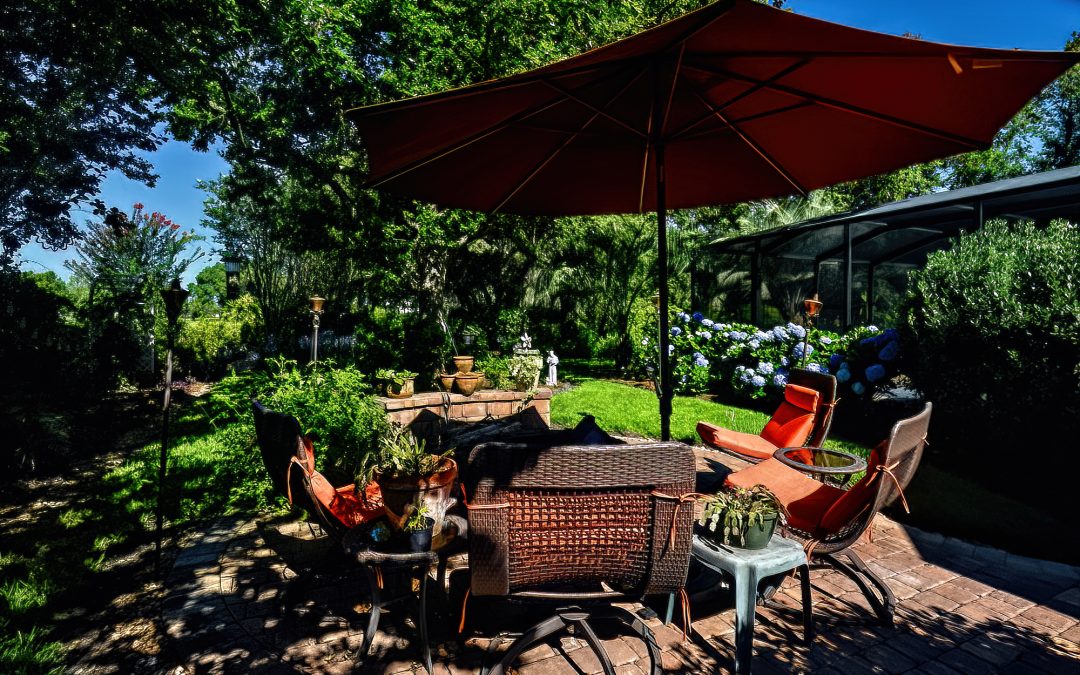(First published in The Magnolia – July 2021 – All Photos by the Author)
Florida has 663 native plants, of which are 326 best suited to grow in Clay County. So what is it? A Florida-Friendly is a landscape that provides a combination of ‘ingredients’ from these categories: wildlife food and water sources, cover, places for wildlife to raise young, and sustainable practices in keeping the whole thing, well, humming.
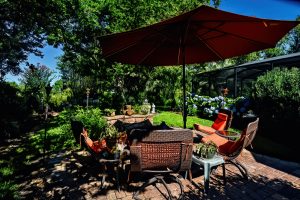
The Triay Backyard
As much satisfaction is derived from appreciating the sights and smells of native fauna in its wild state, ‘Friendly Landscapers’ get quiet thrills watching a somewhat greater variety of native animals make their homes alongside their own, or at least check in as regular visitors. While there’s wildlife everywhere in Magnolia Point, it’s the numbers and variety that’s different in the Friendly yard.
The Florida Native Plant Society (FNPS), maintains a county ‘lookup’ table of plants at: https://www.fnps.org/plants. You can even refine your results by plants most attractive to butterflies, hummingbirds, and/or other wildlife for our area.
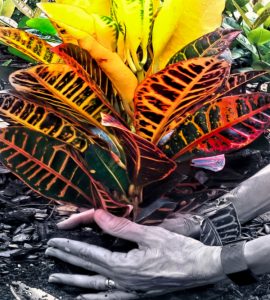
Cindy’s Busy Hands
Starting ten years ago, Cindy applied FNPS principles to a gradual re-make of their property. A little bit at a time was the key.
“Start small. Don’t try to do this overnight,” she says. “I had some help here and there, but did most of it myself. I did have a lot of help with these pavers, though” as I follow Cindy along a trim hardscape path to her backyard.
Pavers? Is this allowed? The vista that unfolds in the backyard challenges my preconceived notions of what these ‘Friendly’ landscapes are all about.
Florida Friendly Myths Debunked
Yes, you can have fun in a Florida Native Yard. The Triay backyard is hardly the jungle you might expect. First up is a ‘Better Homes’ tailored open patio. Pavers are allowed, as are fire pits and umbrellas. And yes, you can have a screened-in pool and still be Florida-Friendly.

Blue Java Bunch
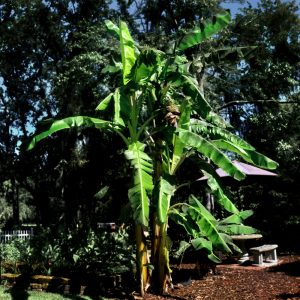
Blue Banana Tree
It’s not a mess. Nor unkempt or unruly: there’s great discipline in maintaining these yards, quelling the urge to nip and tuck. Leave that Crepe Myrtle just as it is; those sprays of new growth are just what songbirds are looking for when they need a break. Likewise with planting. It takes self-control to resist the urge to crowd bulbs and cuttings to re-create a magazine-cover wall of color; but a more natural spacing allows critters to find the refuge they prefer.
Overall, the property is open, inviting, familiar: there are plenty of grassy areas, exclusively St. Augustine, and though tailored and lush, admittedly shrinking by an average of one foot each year as Cindy progresses to a more natural overall look.
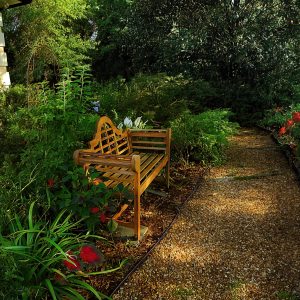
Morning Oasis
It’s not chaos. It’s training the mind’s eye to see the flora and fauna around us more as nature intended, and the rewards can be both subtle and surprising at the same time. I saw butterflies at Cindy’s I know I’ve never seen before and a few uncommon plant specimens in rare startling proportions.
Nothing is forever. You can take things out of the Friendly yard once they’re in; there’s no hard rule about leaving things completely untouched. You learn that some thinning may be necessary to balance plant health, sustainability and wildlife refuge.
It’s not the ‘whole nine yards’. While most think of an entire property as a ‘Florida-Friendly Landscape’ is the most familiar designation, you can also have a smaller area of your whole yard certified Florida-Friendly.
Others can call your Friendly Yard home. You don’t have to give up your favorite plants. Included in Cindy’s yard are some species that are common in other, similar climates. A stunning Staghorn Fern, for example. Overall, Cindy’s yard has more than 50 species of natives. In total, FNPS certification requires that no more than 25% be non-native.
Asked what she likes the most about her yard: “The tranquility,” Cindy smiles.
Throughout the property are nooks and crannies carved into the plantscape, each with a bench, where she

Color and Texture Everywhere
might retreat during the day to rest and take it in. “Not to mention the savings, which can be pretty significant.” Bills for nearly all landscape maintenance and certainly chemicals and fertilizers, she explains, are a thing of the past.
Rounding the corner of her lanai, one is taken by a banana palm towering over one corner of the yard.
“Banana peels,” her fingertips flit outwards, “that’s all I’ve ever fed it!”
Her Blue Banana is the pride of her efforts. “From a bucket to this,” she stuns her visitor, “in one year!” Halfway up the three-trunked, Jack’s Beanstalk-big palm hangs a bulging bunch of its first fruit, “And they taste like ice-cream. We can’t wait!”
How much time does this labor of love take?
“That depends on the season,” Cindy says, “Just like any other yard here.” Overall, she’s calculated, the work required is no more than any traditional property at Magnolia Point.
Cindy is happy to advise fellow residents on the process of ‘going native’; message her through Nextdoor for more information.
The entire process of certifying your yard can be completed easily online; for a glimpse at the process, or to get started, visit https://nwf.org/certifiedwildlifehabitat.
